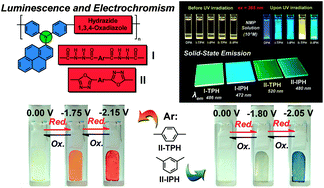Novel luminescent and electrochromic polyhydrazides and polyoxadiazoles bearing pyrenylamine moieties†
Abstract
New aromatic polyhydrazides bearing redox-active pyrenylamine unit were prepared from the polycondensation reactions of

* Corresponding authors
a Department of Chemical Engineering, Tatung University, Taipei, Taiwan
b
Department of Chemical Engineering and Biotechnology, National Taipei University of Technology, Taipei, Taiwan
E-mail:
shhsiao@ntut.edu.tw
New aromatic polyhydrazides bearing redox-active pyrenylamine unit were prepared from the polycondensation reactions of

 Please wait while we load your content...
Something went wrong. Try again?
Please wait while we load your content...
Something went wrong. Try again?
Y. Kung and S. Hsiao, Polym. Chem., 2011, 2, 1720 DOI: 10.1039/C1PY00115A
To request permission to reproduce material from this article, please go to the Copyright Clearance Center request page.
If you are an author contributing to an RSC publication, you do not need to request permission provided correct acknowledgement is given.
If you are the author of this article, you do not need to request permission to reproduce figures and diagrams provided correct acknowledgement is given. If you want to reproduce the whole article in a third-party publication (excluding your thesis/dissertation for which permission is not required) please go to the Copyright Clearance Center request page.
Read more about how to correctly acknowledge RSC content.
 Fetching data from CrossRef.
Fetching data from CrossRef.
This may take some time to load.
Loading related content
